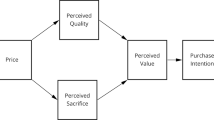Abstract
Background
Research suggests that quantitative information in direct-to-consumer (DTC) prescription drug ads may be helpful for consumers.
Purpose
The objective was to examine the effect of adding placebo rates and framing to DTC ads.
Methods
In study 1, 2,000 Internet panel members with chronic pain participated in a randomized controlled experiment of DTC ads varying in placebo rate and framing. In study 2, 596 physicians ranked DTC ads varying in placebo rate and framing by how well they conveyed scientific information and their usefulness for patients.
Results
In study 1, participants who viewed placebo rates were able to recall them and use them to form certain perceptions. A mixed frame led to lower placebo rate recall and perceived efficacy. In study 2, overall, physicians preferred a placebo/single frame ad.
Conclusions
Adding placebo rates to DTC ads may be useful for consumers. The evidence does not support using a mixed frame.





Similar content being viewed by others
References
Prescription Drug Advertisements, 21C.F.R. Sect. 202.1 (2012).
Woloshin S, Schwartz L, Tremmel J, Welch HG. Direct to consumer advertisements for prescription drugs: What are Americans being sold? Lancet. 2001; 358: 1141-1146.
Fagerlin A, Ubel PA, Smith DM, Zikmund-Fisher BJ. Making numbers matter: Present and future research in risk communication. Am J Health Behav. 2007; 31: S47-S56.
Lipkus I. Numeric, verbal, and visual formats of conveying health risks: Suggested best practices and future recommendations. Med Decis Making. 2007; 27: 697-713.
O'Donoghue AC, Sullivan HW, Aikin KJ, Chowdhury D, Moultrie RR, Rupert DJ. Presenting efficacy information in direct-to-consumer prescription drug advertisements. Patient Educ Couns; in press (available online 25 Dec 2013). doi:10.1016/j.pec.2013.12.010.
Woloshin S, Schwartz LM, Welch HG. Using a drug facts box to communicate drug benefits and harms: Two randomized trials. Ann Intern Med. 2009; 150: 516-527.
Applebaum PS, Roth LH, Lidz C. The therapeutic misconception: Informed consent in psychiatric research. Int J Law Psychiatry. 1983; 5: 319-329.
Stead M, Eadie D, Gordon D, Angus K. “Hello, hello—it’s English I speak!”: A qualitative exploration of patients’ understanding of the science of clinical trials. J Med Ethics. 2005; 31: 664-669.
Miller JD. The measurement of civic scientific literacy. Public Underst Sci. 1998; 7: 203-223.
Petty RE. Two routes to persuasion: State of the art. In: d’Ydewalle G, Eelen P, Bertelson P, eds. International Perspectives on Psychological Science, Vol. 2: The State of the Art. Hillsdale, NJ: Lawrence Erlbaum Associates, Inc.; 1994:229–247.
Schwartz LM, Woloshin S, Welch HG. Using a drug facts box to communicate drug benefits and harms: Two randomized trials. Ann Intern Med. 2009; 150: 516-527.
Tversky A, Kahneman D. The framing of decisions and the psychology of choice. Science. 1981; 211: 453-8.
Schwartz LM, Woloshin S, Welch HG. Risk communication in clinical practice: Putting cancer in context. J Natl Cancer Inst Monogr. 1999; 25: 124-133.
Moxley A, O’Connell D, McGettigan P, Henry D. Describing treatment effects to patients: How they are expressed makes a difference. J Gen Intern Med. 2003; 18: 948-959.
O’Connor AM. Effects of framing and levels of probability on patients’ preferences for cancer chemotherapy. J Clin Epidemiol. 1989; 42: 119-126.
Bernstein LM, Chapman GB, Elstein AS. Framing effects in choices between multi-outcome life-expectancy lotteries. Med Decis Making. 1999; 19: 324-338.
Peters E, Hart PS, Fraenkel L. Informing patients: The influence of numeracy, framing, and format of side effect information on risk perceptions. Med Decis Making. 2011; 31: 432-436.
McNeil B, Pauker SG, Tversky A. On the framing of medical decisions. In: Bell DC, Raffa H, Tversky A, eds. Decision Making: Descriptive, Normative, and Prescriptive Interactions. Cambridge, UK: Cambridge University Press; 1988: 562-568.
Lipkus IM, Samsa G, Rimer BK. General performance on a numeracy scale among highly educated samples. Med Decis Making. 2001; 21: 37-44.
Jeffery RW. Risk behaviors and health: Contrasting individual and population perspectives. Am Psychol. 1989; 44: 1194-1202.
Schwartz LM, Woloshin S, Black WC, Welch HG. The role of numeracy in understanding the benefit of screening mammography. Ann Intern Med. 1997; 127(11): 966-972.
Herr PM, Kardes FR, Kim J. Effects of word-of-mouth and product-attribute information on persuasion: An accessibility–diagnosticity perspective. J Consum Res. 1991; 17: 454-462.
Mizerski RW. An attribution explanation of the disproportionate influence of unfavorable information. J Consum Res. 1982; 9: 301-310.
Finucane ML, Alhakami A, Slovic P, Johnson SM. The affect heuristic in judgments of risks and benefits. J Behav Decis Making. 2000; 13: 1-17.
Slovic P, Peters E. Risk perception and affect. Curr Dir Psychol Sci. 2006; 15: 322-325.
Nelson W, Fagerlin A, Peters E. Clinical implications of numeracy: Theory and practice. Ann Behav Med. 2008; 35: 261-274.
Acknowledgments
The OMB Control Number for this study is 0910-0692. We would like to thank Adam Rosenblatt, M.A., of Penn Schoen Berland for his assistance with data collection and Kayla Gray of RTI International for her assistance with stimuli development. They both received compensation for their work through contracts with FDA. The study was funded by FDA, the organization at which all authors are employed.
Authors’ Statement of Conflict of Interest and Adherence to Ethical Standards
Authors O’Donoghue, Sullivan, and Aikin declare that they have no conflict of interest. All procedures, including the informed consent process, were conducted in accordance with the ethical standards of the responsible committee on human experimentation (institutional and national) and with the Helsinki Declaration of 1975, as revised in 2000.
Author information
Authors and Affiliations
Corresponding author
About this article
Cite this article
O’Donoghue, A.C., Sullivan, H.W. & Aikin, K.J. Randomized Study of Placebo and Framing Information in Direct-to-Consumer Print Advertisements for Prescription Drugs. ann. behav. med. 48, 311–322 (2014). https://doi.org/10.1007/s12160-014-9603-1
Published:
Issue Date:
DOI: https://doi.org/10.1007/s12160-014-9603-1



